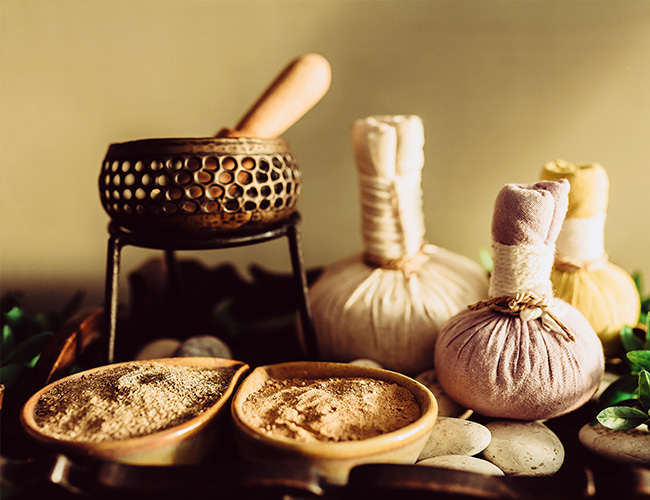Ultimate Ayurvedic Hair Care Routine
Ayurvedic Hair Care Routine: The Vital Steps
1. Know Your Hair Type
According to Ayurveda, the three vital energies Vata, Pitta and Kapha regulate our bodily activities. Each individual is a combination of these tridoshas, with one or two doshas in dominance. This determines your hair type and hair health.
A. Vata Hair Type
You will have a Vata hair type if you have Vata-dominant Prakriti. Proper nutrition to your hair follicles keeps Vata dosha in balance. A normal Vata hair type tends to be thin, straight hair with higher porosity.
When Vata dosha aggravates in your body, it causes dryness of your scalp and hair with very low sebum production. This eventually results in dry and frizzy hair, split ends and hair loss.
B. Pitta Hair Type
You will have a Pitta hair type if you have Pitta dominant Prakriti. Pitta is responsible for metabolic activity in hair, regulates the production of pigments and hair proteins.
A healthy Pitta hair tends to be wavy with a medium thickness. Premature greying, clogged follicles with bacteria build-up, scalp inflammation, redness, hair loss, etc. are caused when Pitta is imbalanced.
C. Kapha Hair Type
You will have a Kapha hair type if you have Kapha dominant Prakriti. Kapha energy is responsible for your hair structure and its lubrication. A healthy Kapha hair is thick, lustrous, and curly.
Any imbalance in Kapha results in overproduction of sebum on your scalp, which eventually leads to oily dandruff with a greasy scalp, itching, hair fall, etc.
Understanding your hair type and ongoing state of your dosha levels helps you involve specific Ayurvedic herbs in your hair care routine that target your unique hair needs.
2. Choose Hair Oil And Shampoo Based On Your Hair Type
Make sure your fundamental hair products, i.e your hair oil and shampoo, contain Ayurvedic herbs that work on your aggravated dosha levels. Choosing wrong hair products may worsen your hair condition and cause an imbalance in your doshas.
Here is the list of few dosha-specific herbs that you can seek in your hair care products:
A. Vata-Pacifying Herbs
Palandu (onion), Gunja (Rosepea), Yashtimadhu (Licorice), Devdar (Cedar), Krishna Tila (black sesame), Saireyaka (Barleria Prionitis), Ashwagandha (Withania Somnifera), Shatavari (Asparagus Racemosus), etc.
B. Pitta-Pacifying Herbs
Yashtimadhu (Licorice), Japa (Hibiscus), Kamala (Nelumbo Nucifera), Nimba (Neem), Lodhra (Symplocos Racemosa), Karanja (Pongamia Pinnata), etc.
C. Kapha Pacifying Herbs
Gunja (Rosepea), Grapeseed, Kushta (Saussurea Costus), Methika (Fenugreek), Karpoora (Camphor), Jyotishmathi (Celastrus Paniculatus), Daruharidra (Berberis Aristata), etc.
D. Tridosha Haras (Herbs To Pacify All Three Doshas)
Kumari (Aloe Vera), Brahmi (Bacopa Monnieri), Bhringraj (Eclipta Alba), Amalaki (Indian Gooseberry), Tagara (Valerian root), etc.
3. Oil Your Hair Regularly
“According to Ayurveda, your scalp is the composition of various energy-relieving points called ‘Marmas’. Oiling your scalp and hair is the rejuvenation tool to extricate any excess or aggravated doshas accumulated in your head through marmas.
Besides rejuvenation, a regular scalp and hair massage with dosha-specific Ayurvedic oils promote healthy, strong and lustrous hair growth with their nourishing, root-strengthening and conditioning properties of herbs.
Ayurveda recommends oiling your hair 2-3 times a week. You can also fix your frequency of oiling based on your hair type. Kapha hair type can be oiled with less frequency whereas the Vata hair type needs more oiling than Pitta and Kapha types.
Traditional Ayurvedic practices involve oiling your hair at least 20 minutes before your hair wash. For better results, massage your scalp and hair with warm oil at night and wash your hair the following day. This works as an exceptional natural conditioning treatment to your scalp and hair.
Procedure
1. Apply warm oil across your scalp.
2. Massage your entire scalp in a circular motion using your finger pads for about 15 minutes.
3. Now, work some oil from your hair roots to tips by giving a gentle massage.
Circular scalp massage stimulates the blood circulation and enhances the oil absorption into deep layers of your scalp. You can also use coconut oil, sesame oil, almond oil, olive oil, etc. to massage your scalp and hair regularly.
4. Wash Your Hair Regularly
Your scalp follicles get clogged with the unwanted build-up of excess oils, dirt and grime, which you need to cleanse out through regular hair wash with Ayurvedic shampoos.
Besides Ayurvedic shampoos with herbs that are specific to your dosha imbalances, you can also opt for natural hair cleansing herbs like Reetha (Soapnut), Shikakai (Soap pod), Hibiscus flowers, Triphala powder, etc. to wash your hair.
Ayurveda recommends you wash your hair twice or thrice in a week with a gentle massage using normal or lukewarm water during your hair wash.
5. Condition Your Hair Regularly With Hair Masks
Hair masks or ‘Shiro lepa’ in Ayurvedic terms is one of the extremely beneficial therapies to nourish and deeply condition your scalp and hair. Ayurveda suggests applying hair masks once in a week or fortnight to keep your scalp and hair in good health while it also helps you combat internal hair loss factors like stress and anxiety.
You can use Ayurvedic herbal powders like Amalaki, henna, fenugreek and solvents like egg white, aloe vera gel, etc. to prepare your nutrients rich hair masks. Apply the mask from your roots to hair tips and leave it for about 30-40 minutes before rinsing it off with water.
6. Learn How To Comb
Combing is one of the effective ways to enhance blood circulation on your scalp. It helps in detangling your hair and spreading your scalp’s natural oils evenly over your hair strands. But, vigorous combing can damage your hair by stretching it and this may lead to hair breakage and split ends.
Ayurveda suggests you comb your hair once or twice gently using a wooden blunt-toothed comb. Also, wash your comb regularly to avoid dirt accumulation and do not share your comb with others.
7. Trim Your Hair Regularly
Broken hair with split ends gives a thin and rough look to your hair tips. You can avoid this by getting rid of split ends through regular trimming. Ensure you eliminate your split ends by trimming your hair every 8-12 weeks.
8. Avoid Chemical Products
The harsh chemicals used in hair products may change your scalp pH while they can strip off the natural oils from your scalp and protein layers from your hair. Switch to Ayurvedic products with natural herbal ingredients to attain holistic hair health without unwanted risks.
9. Avoid Heat Styling
Overuse of heat styling tools like blow-dryers, straightening or curling irons, etc. leave your hair moisture-less over time, which may lead to serious damage to your hair. It spikes up Vata dosha causing dryness, breakage, split ends and hair fall. It is better to leave your hair for air drying after your hair wash.
10. Protect Your Hair From Harsh Environment
Environmental pollution and UV radiation damage your hair follicles by tampering with your scalp’s natural oils. It also makes your hair brittle and dull. On top of that, excessive intake of alcohol and cigarettes may worsen your condition causing severe hair loss.
Make sure you wear a cap or scarf to protect your hair when you go outside or swim in chlorinated water. Avoid the consumption of cigarettes and alcohol for better hair health.
“Ayurveda suggests applying oil to your hair before going under the sun as it acts as a protective layer to your scalp and hair tissues,’’














